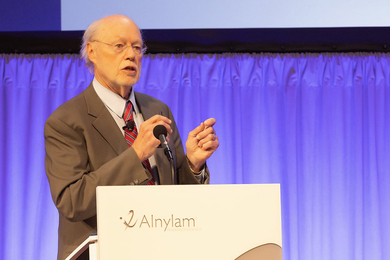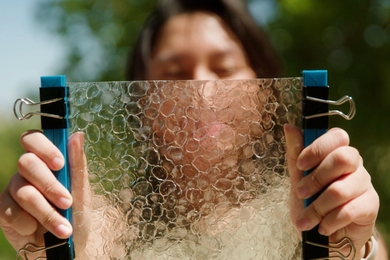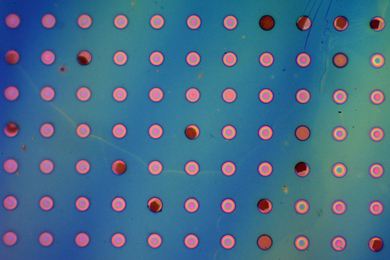Building on the "perfect mirror" they created in 1998, MIT researchers have proposed a new kind of coaxial cable that may be able to quickly and efficiently shoot light over long distances and around sharp bends while retaining its polarization.
The all-dielectric coaxial cable, described in the cover story of the July 21 issue of Science, may create the kind of fast, high-bandwidth conduit needed for today's Internet applications.
With its ability for higher capacity, this cable may be able to transmit much more information more efficiently and cheaply than current methods. It also could lead to significant miniaturization of integrated optical devices.
"What's important about this is that it has opened a new direction for experimental research that was not possible before," said John D. Joannopoulos, the Francis Wright Davis Professor of Physics and the team leader. "It's important to push along in this direction and see if we can find materials and fabrication approaches that will make this happen. We do know if we can do what the theory says, it will happen. This may be a breakthrough in bridging the very different requirements for transmitting infrared and radio frequencies" at opposite ends of the energy spectrum.
In addition to Professor Joannopoulos, authors are Mihai Ibanescu (SB 2000 and now a graduate student in physics); Shanhui Fan, research scientist in the Research Laboratory of Electronics (RLE); Yoel Fink, an RLE postdoctoral associate who will be an assistant professor of materials science and engineering in the fall; and Edwin L. Thomas, the Morris Cohen Professor of Materials Science and Engineering and deputy director of the Microphotonics Center.
A HIGHLY REFLECTIVE MIRROR
The familiar metallic mirror is omnidirectional, which means it reflects light from every angle. It also absorbs a significant portion of the incident light in the optical regime.
Dielectric mirrors, unlike metals, do not conduct electricity, so their response to light can be very different. Light travels in dielectric materials at speeds that are lower than in air. When light traveling in a particular direction through one type of dielectric material encounters another type, part of the light is reflected while the other part is transmitted at a different angle.
Dielectric mirrors are made of multiple layers of transparent dielectric materials. Such materials, which can be made to be extremely low loss compared to their metal counterparts, are used to reflect a prescribed range of frequencies coming from within a limited set of angles. Dielectric mirrors are used in devices such as lasers, which need low losses and high reflectivity.
The new kind of mirror developed in 1998 by Drs. Fink, Fan, Joannopoulos and Thomas -- dubbed the "perfect mirror" -- reflects light from all angles and polarizations just like metallic mirrors, but also can be as low-loss as dielectric mirrors (see MIT Tech Talk, December 9, 1998).
BUILDING ON PERFECTION
Working with Mr. Ibanescu, these researchers then made a tube out of the perfect mirror to create an omnidirectional waveguide. Unlike conventional waveguides, which need to make wide turns to ensure that the light within them does not escape, the omnidirectional waveguide can turn light quickly and efficiently in small spaces.
This would allow a slew of new technological advances in devices such as an optical chip, which cannot now be miniaturized because bending the light's route takes up so much space. In addition, the new waveguide can accommodate a much wider bandwidth of light.
Professor Thomas said the waveguide may have applications in medical lasers, among other devices.
Taking the waveguide a step farther, Professor Joannopolous proposed that the omnidirectional reflector could be fashioned like a conventional coaxial cable, which consists of a tube of metal with a metal core snaking down its center. Coaxial cable is used to transmit radio and microwaves, which have large wavelengths, but it is not good for light energy at the smaller-wavelength, higher-frequency end of the spectrum.
Fiber optic cable was created to fill that need. But light transmitted through fiber optic cable does not maintain its polarization, which is important for certain high-tech applications. Using dielectrical materials instead of metal or fiber optics may bridge both worlds.
"This coaxial omniguide may be able to replace what metal does, and also do the job at wavelengths where metal doesn't work," Professor Joannopoulos said. "And the nice thing about it is that whatever you put in, you get out. This could make a big difference" where polarization is an issue.
The next step is to prototype and test the coaxial omniguide. Drs. Fink, Joannopolous, Thomas and others have launched a new company, OmniGuide Communications Inc., to explore its practicality.
This work is funded by the Center for Materials Science and Engineering through the National Science Foundation, the US Department of Energy and the US Army Research Office.
A version of this article appeared in MIT Tech Talk on August 23, 2000.





